公示语汉译英翻译常见错误
- 格式:doc
- 大小:29.00 KB
- 文档页数:4
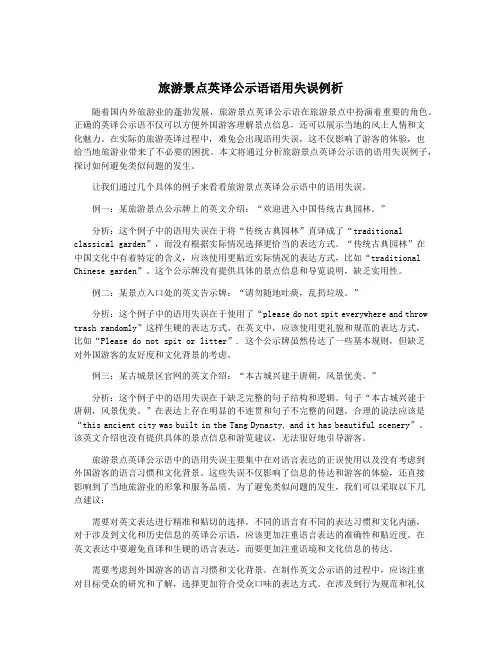
旅游景点英译公示语语用失误例析随着国内外旅游业的蓬勃发展,旅游景点英译公示语在旅游景点中扮演着重要的角色。
正确的英译公示语不仅可以方便外国游客理解景点信息,还可以展示当地的风土人情和文化魅力。
在实际的旅游英译过程中,难免会出现语用失误,这不仅影响了游客的体验,也给当地旅游业带来了不必要的困扰。
本文将通过分析旅游景点英译公示语的语用失误例子,探讨如何避免类似问题的发生。
让我们通过几个具体的例子来看看旅游景点英译公示语中的语用失误。
例一:某旅游景点公示牌上的英文介绍:“欢迎进入中国传统古典园林。
”分析:这个例子中的语用失误在于将“传统古典园林”直译成了“traditional classical garden”,而没有根据实际情况选择更恰当的表达方式。
“传统古典园林”在中国文化中有着特定的含义,应该使用更贴近实际情况的表达方式,比如“traditional Chinese garden”。
这个公示牌没有提供具体的景点信息和导览说明,缺乏实用性。
例二:某景点入口处的英文告示牌:“请勿随地吐痰,乱扔垃圾。
”分析:这个例子中的语用失误在于使用了“please do not spit everywhere and throw trash randomly”这样生硬的表达方式。
在英文中,应该使用更礼貌和规范的表达方式,比如“Please do not spit or litter”. 这个公示牌虽然传达了一些基本规则,但缺乏对外国游客的友好度和文化背景的考虑。
例三:某古城景区官网的英文介绍:“本古城兴建于唐朝,风景优美。
”分析:这个例子中的语用失误在于缺乏完整的句子结构和逻辑。
句子“本古城兴建于唐朝,风景优美。
”在表达上存在明显的不连贯和句子不完整的问题。
合理的说法应该是“this ancient city was built in the Tang Dynasty, and it has beautiful scenery”。

语用学视野下公示语英译中的失误汇报人:2023-12-17•引言•公示语英译中的常见失误•语用学角度下的失误分析目录•公示语英译中的优化策略•案例分析与实践应用•结论与展望01引言公示语的定义与重要性定义公示语是一种面向公众的、具有特定功能的文本,用于传达信息、指示、警告或提示等。
重要性公示语在日常生活中随处可见,对于人们的生活和工作具有重要意义。
正确的公示语翻译有助于提高公众的生活质量,促进跨文化交流。
语用学在公示语翻译中的应用语用学概念语用学是研究语言使用和理解的学科,关注语言在特定语境中的意义和功能。
在公示语翻译中的应用在公示语翻译中,语用学可以帮助我们理解源语言和目标语言之间的文化差异,从而更准确地传达信息。
同时,语用学还可以指导我们如何选择合适的词汇和表达方式,以使公示语更易于理解和接受。
02公示语英译中的常见失误词汇选择不当专有名词错译在公示语翻译中,专有名词的错译是常见的失误之一。
例如,将“人民公园”错译为“people's park”,正确的翻译应该是“People's Park”。
词汇搭配不当在英语中,某些词汇的搭配是固定的,而中文的词汇搭配则较为灵活。
如果翻译时没有注意到这一点,就容易出现搭配不当的错误。
例如,“保持安静”被错译为“keep quiet”,正确的翻译应该是“keep silence”。
公示语中的信息通常是针对未来的,因此应该使用将来时态。
然而,在翻译过程中,如果不注意时态的转换,就容易出现时态错误。
例如,“已经售罄”被错译为“already sold out”,正确的翻译应该是“will be sold out”。
语态错误公示语中的信息通常是要求受众采取某种行动,因此应该使用祈使句或被动句。
然而,在翻译过程中,如果不注意语态的转换,就容易出现语态错误。
例如,“请勿践踏草坪”被错译为“Don't step on the lawn”,正确的翻译应该是“Keep off the lawn”。
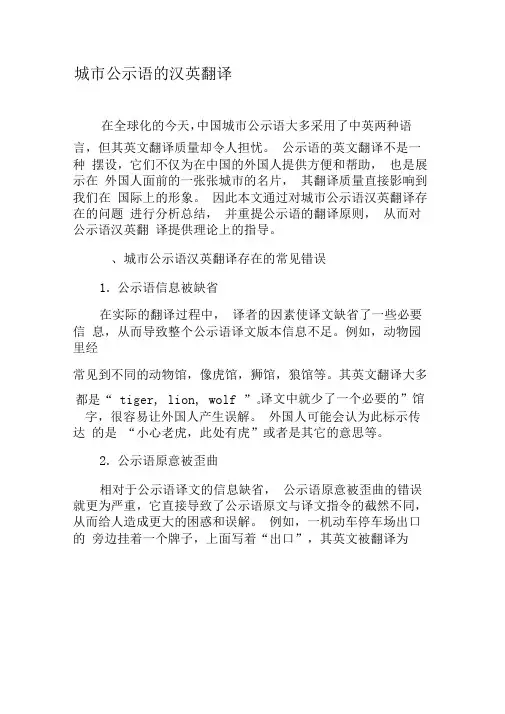
城市公示语的汉英翻译在全球化的今天,中国城市公示语大多采用了中英两种语言,但其英文翻译质量却令人担忧。
公示语的英文翻译不是一种摆设,它们不仅为在中国的外国人提供方便和帮助,也是展示在外国人面前的一张张城市的名片,其翻译质量直接影响到我们在国际上的形象。
因此本文通过对城市公示语汉英翻译存在的问题进行分析总结,并重提公示语的翻译原则,从而对公示语汉英翻译提供理论上的指导。
、城市公示语汉英翻译存在的常见错误1.公示语信息被缺省在实际的翻译过程中,译者的因素使译文缺省了一些必要信息,从而导致整个公示语译文版本信息不足。
例如,动物园里经常见到不同的动物馆,像虎馆,狮馆,狼馆等。
其英文翻译大多都是“ tiger, lion, wolf ”。
译文中就少了一个必要的”馆字,很容易让外国人产生误解。
外国人可能会认为此标示传达的是“小心老虎,此处有虎”或者是其它的意思等。
2.公示语原意被歪曲相对于公示语译文的信息缺省,公示语原意被歪曲的错误就更为严重,它直接导致了公示语原文与译文指令的截然不同,从而给人造成更大的困惑和误解。
例如,一机动车停车场出口的旁边挂着一个牌子,上面写着“出口”,其英文被翻译为Export ”。
其实这是” Exit ”的误用, 外国人肯定百思不得其 解,此处出口什么? 出口汽车吗?3. 译文语气使用不当公示语的语气也非常重要, 但是很多公示语英语译文就没 有很好地传达原文的语气, 从而导致语气不当, 或太强或太弱, 因而达不到最佳的公示效果。
例如, 在很多服务场所经常看到贵客止步“的提示,其英文翻译很多情况下被处理成了 ” 等, 这些英文翻 only. ” 才更为妥当。
4. 译文术语搭配不当由于译者对一些固定术语搭配结构不熟悉, 公示语英语译文 不能达到预期效果, 从而可能导致对公示语的误解。
例如“留学 生公寓”被英译为了“ Foreign Stude nts DormitoryBuilding ”, 或许在过去还可以接受, 但是随着时代的变化它已 经过时,继续使用就显的不合时宜。
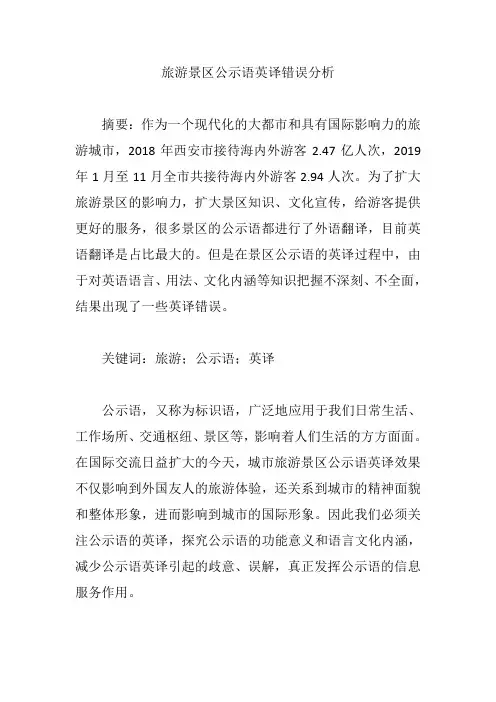
旅游景区公示语英译错误分析摘要:作为一个现代化的大都市和具有国际影响力的旅游城市,2018年西安市接待海内外游客2.47亿人次,2019年1月至11月全市共接待海内外游客2.94人次。
为了扩大旅游景区的影响力,扩大景区知识、文化宣传,给游客提供更好的服务,很多景区的公示语都进行了外语翻译,目前英语翻译是占比最大的。
但是在景区公示语的英译过程中,由于对英语语言、用法、文化内涵等知识把握不深刻、不全面,结果出现了一些英译错误。
关键词:旅游;公示语;英译公示语,又称为标识语,广泛地应用于我们日常生活、工作场所、交通枢纽、景区等,影响着人们生活的方方面面。
在国际交流日益扩大的今天,城市旅游景区公示语英译效果不仅影响到外国友人的旅游体验,还关系到城市的精神面貌和整体形象,进而影响到城市的国际形象。
因此我们必须关注公示语的英译,探究公示语的功能意义和语言文化内涵,减少公示语英译引起的歧意、误解,真正发挥公示语的信息服务作用。
1旅游景区公示语的应用功能(1)指示性公示语:指示性公示语主要用于信息服务,没有任何限制、强制意义,其功能在于指示服务内容。
例如:TicketOffice(售票处)、restroom(休息室)、Souvenirs(旅游纪念品)、Toilet(卫生间)、OfficeArea(办公区)、Park (停车区)等。
(2)提示性公示语:提示性公示语仅起提示作用,没有任何特指意义。
例如:WetPaint(油漆未干)、MindtheSteps(注意台阶)、DeepWater(水深)。
(3)限制性公示语:此类公示语对相关公众的行为提出限制、约束和要求,语言直接了当,但不会使人感到强硬、粗暴、无理。
例如:KeepQuiet(保持安静)、ChildrenandSeniorCitizensFree (老人小孩免费)、StaffOnly(游客止步)、TicketOnly(凭票入内)等。
(4)强制性公示语:强制性公示语要求相关公众必须采取或不得采取任何行动,语言直白,具有强制性。

城市公示语翻译的错误类型及解决措施1. IntroductionWith many places famous for its natural sceneries and historical relics, China is predicted to be the most frequently-visited country in the world and the fourth largest suppliers of tourists in next few years. During these years, some tourist resorts have attracted thousands of visitors from all over the world. For the foreigners, the public signs in the tourist attractions are windows to get a better understanding of China. As a global language, English is given the priority to be the corresponding equivalence of the public signs in Chinese. The data and examples are collected from public signs, travel brochures, and websites of the tourist attractions. Among these translations, some public signs are good and standard. However, the general situation is far from satisfactory. Besides some noticeable lexical and grammatical errors, improper and confusing expressions are ubiquitous. This kind of translation not only fails to achieve the information, intentions and functions of the signs, but also affects the whole image of China and thus the Chinese tourism industry.Informative, appropriate and attractive translations of public signs are urgently needed. Translators following the guidance of a scientific translation theory could work more effectively. Translation theory put forward by Peter Newmark can explain these unsatisfactory translation phenomena and his communicative translation strategy is helpful to improve the current situation in C-E translation of public signs in tourist attractions.2. An Overview of Communicative Translation2.1 Newmark‟s Text TypologyBühkler sorts the functions of language into three types: the expression, representation and appeal function. And based on it, Jacobson (Newmark, Peter2001) [1]classifies language into six functions: the expressive, informative, vocative, phatic, metalingual and aesthetic function. Peter Newmark absorbs these two theories critically and establishes his text typology. He divides the texts into three main types: the expressive, the informative and the vocative texts.“The core of the expressive text is the mind of the speaker, the writer, the originator of the utterance”. (Newmark, Peter 2001) [2] The author uses the utterance to express his feeling irrespective of any response. Expressive text focuses on the author‟s status in translation, thus it‟s author-centered and it means the author‟s status in the original texts is emphasize d. Typical texts of this type include autobiography, literature like poetry, novels and plays, and authoritative statements such as documents, political speeches, and scientific, philosophical and academic works.“The informative text stresses the“external situation, reality outside language, includingreported ideas or theories”. (Newmark, Peter 2001) [2] The information is what the author intends to deliver to the reader or audience. Textbooks, technical reports, articles in newspapers or periodicals, public signs, scenic spots introductions, scientific papers, and thesis are typical of the informative text.The function of the vocative text is to “call upon the readership to act, think or feel, in fact to …react‟ in the way intended by the text”. (Newmark, Peter2001)[2]According to Newmark, two factors are essential to the vocative texts, namely, the relationship between the reader and the writer, the comprehensibility and readability of the texts. Typical vocative texts include notices, instructions, publicity, advertisements, and persuasive writing.Although a text of pure function and purpose can seldom be found, from a broader perspective, texts can be all classified into these three types. And to different types of text, according to Newmark, two kinds of translation strategies can be applied.2.2Communicative Translation V.S. Semantic TranslationThe main concern of translation theory is to determine appropriate translation methods for the widest possible range of text. The long dispute over the chosen between literal translation and liberal translation can be ended by Newmar k‟s translation theory. The two translation strategies proposed by Newmark are appropriate to any text based on his text typology, i.e. communicative and semantic translation. Communicative translation attempts to produce on its readers an effect as close as possible to that obtained on the readers of the original; and semantic translation attempts to render, as closely as the semantic and syntactic structures of the second language allow, the exact contextual meaning of the original. Eugene Nida (Newmark, Peter 2001)[2]comments that Newmark‟s major contribution to translation is putting forward communicative and semantic translation. And the distinction becomes especially relevant for the diversity of texts.The goal of communicative translation is to produce the same effect on the TL readers as that produced by the original texts on the ST readers. Instead of just mirroring the words of ST, communicative translation maintains that the translation should be target language-oriented in the aspect of linguistics, culture and pragmatics. It caters more to the TL readers by producing the messages of the original. Thus readability and naturalness are the criteria for communicative translation. By restructuring or rearranging the clause and reinforcing the emphasis, the translator has the right and responsibility to meet the criteria.To help readers to fully comprehend the text, communicative translation makes the translation closer to them and transfers the social value, cultural elements and language peculiarities imbued in the original text into the TL translation. Thus the translator is given more liberty dealing with the source text. He/she can reset the sentences to serve in the interests of the target reader when thinking that translating the original text which is somewhat awkward or liable to cause misunderstandings in the original sentence sequence.Communicative translation is applied when non-authoritative texts are translated, taking public signs in tourist attractions for example.In contrast, semantic translation is a mode of text transfer which involves using only syntactic and semantic constrains of the TL to duplicate the exact contextual meaning the author intends. It focuses on the semantic content of the SL text and attaches equal importance to the style of the text. Priority is given to the meaning and form of the original. When translating authoritative texts, including literature, religious texts and legal texts, the translator should apply the methodof semantic translation.According to Newmark, communicative translation is applied for “informative” and “vocative” texts, and semantic translation is for “expressive” text. Although the two strategies are different from each other, he remarks that “communicative an d semantic translation may well coincide” because actually there are overlaps of communicative and semantic translation methods. There is no clear-cut line separating semantic translation from communicative translation, nor is there an indicator showing which part of a text is expressive, informative or vocative. The two methods are complementary in dealing with specific translation problems and the three text types are mingled with one another in a text. But some texts intend to lay particular stress on one text type, some others on another. Therefore, a translation can be more or less communicative or more or less semantic.3. An overview of public signs3.1The Definition of Public Signs“Public signs” is new general fashionable vocabulary which is verbal language read in public. The public signs are the words and image information including instructions,; display; alarming and etc., that relate to live hood; manufacture and life.(Hefa Lv,2005;9)[3]Public signs have great range of usage, and deep into all aspects of life. Guideboard, advertising board, road sign, shop signs, warnings, slogan, tourist attractions introduction and ect., All reflects the overall quality of the society and self-cultivation and mental attitude.3.2The classification of Public SignsZongsheng Dai and Hefa Lv point it out that there are 4 functions of public signs are Directive; prompting function; Restrictive;Mandatory. ( Wang Yin Hefa Lv 2007) [4]3.2.1 Directive functionDirective function: directive function that is not restrictive and mandatory provides thoughtful information services and it asks not the actions taken by readers, however, it just uses to indicate content of service. For examples:Conference Center: 会议中心Washing Bay: 洗车场International Departure: 国际出发Super Market: 超级市场These public signs have been significantly used in cities or facilities of tourist attraction and religious clubs and foreign institutions and etc.. Lots of nouns are used in language style showing “Static State” information.3.2.2 Promoting FunctionThe major purpose of promoting public signs is to promote the readers, but has no particular meaning. The usage of these is wide enough, such as:Check In:入住登记Admission Free: 免费入场Cable Car Entrance: 缆车入口Smoke-Free Scenic Area:无烟景区Verbs phrase and noun phrase that is characterized by few words and easy identification are applied in this public signs.3.2.3 Restricted FunctionRestricted public signs are always straightforward in wording with a view to constrict and limit relative actions of common people. For instance:Ticket Only: 凭票入场Keep Silence: 保持安静Give Way to Buses: 公交优先Keep Distance :保持车距3.2.4 Mandatory FunctionRestricted signs require correlation public to take actions or not to take any actions. The language features are frank and the tones is stiff and prohibit firsthand and order people to take some certain actions. Like:No Parking: 禁止停车No Littering: 请勿乱扔废弃物No Smoking: 禁止吸烟“As for the pragmatic function of public functions, the ecological and environmental protection is also the vital function, excepting the 4 functions above”(王银泉.2007,5) [5]. Like “ Don‟t pick flowers”, “ Shopping with cloth bag is fashionable” and etc. Public signs which are simple, specified; standard; and etc. connect the specification patterns and personalization so as to become a special social dialect. It‟s aiming at restrain the public such as calling people to obey the social morality, and prohibiting any actions that do harm to the public.4. The translation problems of public signs4.1 Linguistic translation errors (pragmatic errors)Finding linguistic translation errors that means linguistic translation itself has no problems; linguistic translation errors are not easy to be noticed in that it differs from grammatical errors which just does not comply with idiomatic expression of target language, or occurs in improper context so that the readers feel confused and unsatisfied. The grammatical errors may be caused by authors low language proficiency; carelessness. All of this can be avoided. However, linguistic translation errors are elusive and hard to discover so that the results caused by it is more severe than grammatical errors.Grammatical errors wo n‟t produce side effect on readers, nevertheless, Linguistic translation errors are likely to cause mistakes, what is worse, the errors like that may hurt readers or make readers laugh. As an old saying says“Grammatical errors”indicates that speakers do not have good command of language, but linguistic translation errors manifest the quality of speakers.Let‟s view some typical examples of public signs. “闲人免进” is translated into “No Lazy People” . This kind of translation method which is funny only is milli on miles away from the meaning from original one. The standard one is “Staff only”. “出口” is translated into“Export”. As a result, it becomes another one“出口”.The accurate translation is “Exit”. “欢迎再次光临” is translated into“Welcome You Again”. This kind of version makes friends of foreign countries feel unfriendly and polite and confused. Idiomatic translation of this is “Welcome Back”.Figure 1. Common non-standard public signs“小心路滑”is translated into“Carefully slide”which is totally another meaning. The right one is “Caution, Wet Floor”.Figure 2. Common non-standard public signs“请勿吸烟” is translated into“Thank you for not smoking”which is not idiomatic and demoded. The most idiomatic one is “No Smoking”.4.2 The classification of public signs4.2.1 MisspellingThis kind of error includes increasing or decreasing alphabet when spelling; spelling some words separately, and wrong writing or incorrect spelling. For example,PIC 1-3Figure 3. Common non-standard public signsThe clothing in shop is translated into “Womenswear”(女装); actually the correct translation is “Ladies‟ dress”. “太和门” is translated into “Gate of Supreme Harmony”. The exact translation is“Gate of Supreme Harmony”4.2.2 Grammatical errorsThe second one is grammar errors. Single or plural forms, tense, voice and agreement of categories are the elements which frequently cause problems in Chinese to English translation.Figure 4. Common non-standard public signsFor example, “严禁随地吐痰” is translated into “Rigorous spit everywhere” instead of “No Spitting” or “Please Don‟t Spit”.Grammatical errors are the most common error of public signs translation, for instance, the improper use of singular and plural of noun; tenses of verb are wrong; wrong usages of verbs and noun and etc. The following is the common misuse of public signs:Figure 5. Common non-standard public signs“女卫生间”is translated into “Woman”. This sentence wants to focus on the “plural”. First, it should be “Women”, second, it is not comply with international standard. The accurate and authentic translation of this is “Ladies”. “请勿乱对垃圾”is translated into “No Litter”. The verb “litter” is adopted in a wrong way. It should be“No Littering”.Figure 6. Common non-standard public signsFigure 7. Common non-standard public signs“男卫生间” is “MAIE” which incorrectly uses incorrectly singular and plural of noun. It should be “Gents”. “女卫生间”is“FAMAIE”which incorrectly uses incorrectly singular and plural of noun. It should be “Ladies”.The crucial reason for this error is that the translator is not qualified who can not use the method of application of public signs well so as to cause low-level grammatical errors. Of course, but more often, it belongs to translator‟s carelessness, or the translator has no time to check and review since time is tight.4.2.3 Lexical errorsLexical errors cover: collocation error; mixing synonyms; semantic ambiguity and etc. The exit of some shopping mall says “欢迎您再来” which is translated into “Welcome you to come”, however, the collocation of “Welcome‟‟ is not right. The proper translation is “We Welcome You to Come Back” or “Please come agai n﹗” “铜陵市支行” which is put into “TONGLING SHI COUNTRY SUB BRANCH” the sign mixes English and Chinese up and uses both o f the two languages to translate. “TONGLING CITY‟‟ should be used instead of “TONGLING SHI‟‟ And , using “branch‟‟ is enough to convey the meaning “支行‟‟, so it is cumbersome to add “sub”. The version “TONGLING CITY BRANCH‟‟ is accepted.4.2.4 Cultural translation errorsIt is impossible to separate the use of a language from the culture in which the language is deeply embedded. The interwoven relationship between language and culture has a dual sense. Language is a part of culture and plays a very important role in it.4.2.5 Unidiomatic ExpressionsCustom culture refers to a kind of custom resulting from long-period social life and activities. There are so many aspects being different between English and Chinese, such as greeting, appellation, giving thanks, apologizing, complimenting and making phones. For instance, when people greet others, Chinese people always ask:“Have you finished your work?”“Where are you going?”“What are you doing”By contrast, in western culture, there are real question, so they will feel weird and think“will you be ready for my dinner?”“Where am I going and what am I doingis none of your business.”Figure 8. Common non-standard public signsExample 2, English version: ORGANISM, the meaning of Chinese words and identity are always obscure and the readers have to understand the whole writing from the context. The right one is “Unrecyclable”4.2.6 ChinglishIt‟s word-for-word translation among which some are called Chinglish. This may lead to misunderstandings by the foreigner s. For example, “上楼”is translated into “Up Stair”. Though there is no error and it does express the literal meaning of the Chinese, it does not in accordance with language habits of English thus loses the function of direction.Taking words literally is considerate into Chinglish which means mechanical translating words by words and sitting by number. It does not take the lexical connotation and order of English which causes a whale of a difference between the native English and translation version. Take so me scenic spots translation for example: “注意安全” is interpreted into “notice safety” which is said “注意” is “notice” and “安全” becomes “safety” more instances like below:(1)必须安全带帽。
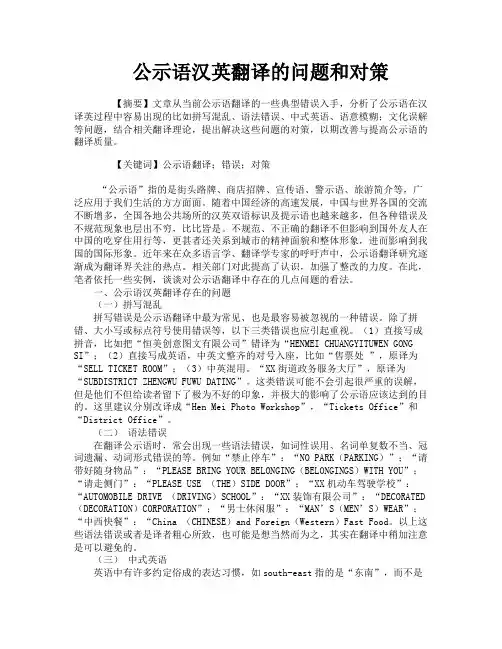
公示语汉英翻译的问题和对策【摘要】文章从当前公示语翻译的一些典型错误入手,分析了公示语在汉译英过程中容易出现的比如拼写混乱、语法错误、中式英语、语意模糊;文化误解等问题,结合相关翻译理论,提出解决这些问题的对策,以期改善与提高公示语的翻译质量。
【关键词】公示语翻译;错误;对策“公示语”指的是街头路牌、商店招牌、宣传语、警示语、旅游简介等,广泛应用于我们生活的方方面面。
随着中国经济的高速发展,中国与世界各国的交流不断增多,全国各地公共场所的汉英双语标识及提示语也越来越多,但各种错误及不规范现象也层出不穷,比比皆是。
不规范、不正确的翻译不但影响到国外友人在中国的吃穿住用行等,更甚者还关系到城市的精神面貌和整体形象,进而影响到我国的国际形象。
近年来在众多语言学、翻译学专家的呼吁声中,公示语翻译研究逐渐成为翻译界关注的热点。
相关部门对此提高了认识,加强了整改的力度。
在此,笔者依托一些实例,谈谈对公示语翻译中存在的几点问题的看法。
一、公示语汉英翻译存在的问题(一)拼写混乱拼写错误是公示语翻译中最为常见、也是最容易被忽视的一种错误。
除了拼错、大小写或标点符号使用错误等,以下三类错误也应引起重视。
(1)直接写成拼音,比如把“恒美创意图文有限公司”错译为“HENMEI CHUANGYITUWEN GONG SI”;(2)直接写成英语,中英文整齐的对号入座,比如“售票处”,原译为“SELL TICKET ROOM”;(3)中英混用。
“XX街道政务服务大厅”,原译为“SUBDISTRICT ZHENGWU FUWU DATING”。
这类错误可能不会引起很严重的误解,但是他们不但给读者留下了极为不好的印象,并极大的影响了公示语应该达到的目的。
这里建议分别改译成“Hen Mei Photo Workshop”,“Tickets Office”和“District Office”。
(二)语法错误在翻译公示语时,常会出现一些语法错误,如词性误用、名词单复数不当、冠词遗漏、动词形式错误的等。
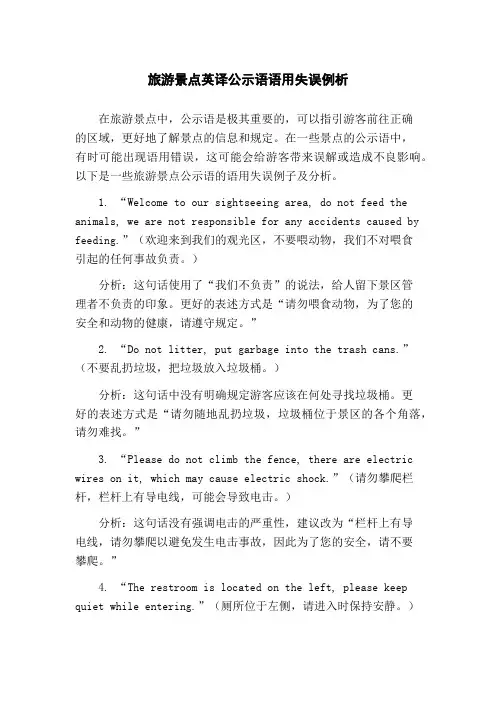
旅游景点英译公示语语用失误例析在旅游景点中,公示语是极其重要的,可以指引游客前往正确的区域,更好地了解景点的信息和规定。
在一些景点的公示语中,有时可能出现语用错误,这可能会给游客带来误解或造成不良影响。
以下是一些旅游景点公示语的语用失误例子及分析。
1. “Welcome to our sightseeing area, do not feed the animals, we are not responsible for any accidents caused by feeding.”(欢迎来到我们的观光区,不要喂动物,我们不对喂食引起的任何事故负责。
)分析:这句话使用了“我们不负责”的说法,给人留下景区管理者不负责的印象。
更好的表述方式是“请勿喂食动物,为了您的安全和动物的健康,请遵守规定。
”2. “Do not litter, put garbage into the trash cans.”(不要乱扔垃圾,把垃圾放入垃圾桶。
)分析:这句话中没有明确规定游客应该在何处寻找垃圾桶。
更好的表述方式是“请勿随地乱扔垃圾,垃圾桶位于景区的各个角落,请勿难找。
”3. “Please do not climb the fence, there are electric wires on it, which may cause electric shock.”(请勿攀爬栏杆,栏杆上有导电线,可能会导致电击。
)分析:这句话没有强调电击的严重性,建议改为“栏杆上有导电线,请勿攀爬以避免发生电击事故,因此为了您的安全,请不要攀爬。
”4. “The restroom is located on the left, please keep quiet while entering.”(厕所位于左侧,请进入时保持安静。
)分析:这句话中没有明确规定游客应该如何保持安静,更好的表述方式是“请进入时保持安静,避免影响其他游客和附近的居民。
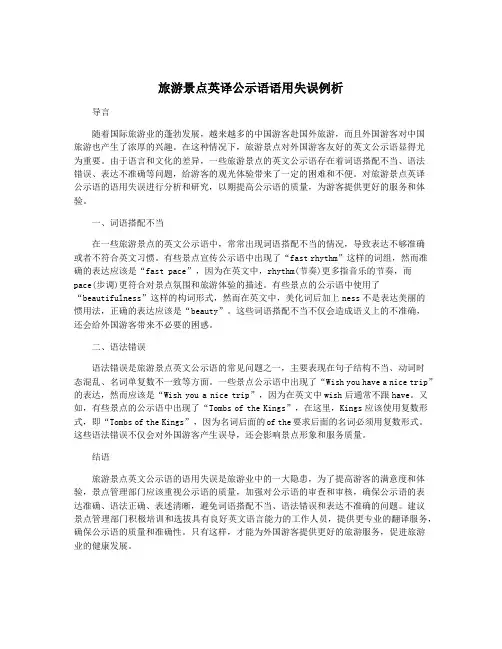
旅游景点英译公示语语用失误例析导言随着国际旅游业的蓬勃发展,越来越多的中国游客赴国外旅游,而且外国游客对中国旅游也产生了浓厚的兴趣。
在这种情况下,旅游景点对外国游客友好的英文公示语显得尤为重要。
由于语言和文化的差异,一些旅游景点的英文公示语存在着词语搭配不当、语法错误、表达不准确等问题,给游客的观光体验带来了一定的困难和不便。
对旅游景点英译公示语的语用失误进行分析和研究,以期提高公示语的质量,为游客提供更好的服务和体验。
一、词语搭配不当在一些旅游景点的英文公示语中,常常出现词语搭配不当的情况,导致表达不够准确或者不符合英文习惯。
有些景点宣传公示语中出现了“fast rhythm”这样的词组,然而准确的表达应该是“fast pace”,因为在英文中,rhythm(节奏)更多指音乐的节奏,而pace(步调)更符合对景点氛围和旅游体验的描述。
有些景点的公示语中使用了“beautifulness”这样的构词形式,然而在英文中,美化词后加上ness不是表达美丽的惯用法,正确的表达应该是“beauty”。
这些词语搭配不当不仅会造成语义上的不准确,还会给外国游客带来不必要的困惑。
二、语法错误语法错误是旅游景点英文公示语的常见问题之一,主要表现在句子结构不当、动词时态混乱、名词单复数不一致等方面。
一些景点公示语中出现了“Wish you have a nice trip”的表达,然而应该是“Wish you a nice trip”,因为在英文中wish后通常不跟have。
又如,有些景点的公示语中出现了“Tombs of the Kings”,在这里,Kings应该使用复数形式,即“Tombs of the Kings”,因为名词后面的of the要求后面的名词必须用复数形式。
这些语法错误不仅会对外国游客产生误导,还会影响景点形象和服务质量。
结语旅游景点英文公示语的语用失误是旅游业中的一大隐患,为了提高游客的满意度和体验,景点管理部门应该重视公示语的质量,加强对公示语的审查和审核,确保公示语的表达准确、语法正确、表述清晰,避免词语搭配不当、语法错误和表达不准确的问题。
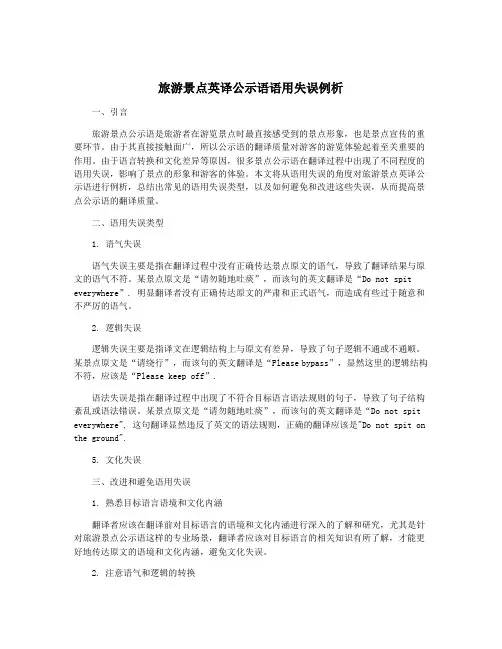
旅游景点英译公示语语用失误例析一、引言旅游景点公示语是旅游者在游览景点时最直接感受到的景点形象,也是景点宣传的重要环节。
由于其直接接触面广,所以公示语的翻译质量对游客的游览体验起着至关重要的作用。
由于语言转换和文化差异等原因,很多景点公示语在翻译过程中出现了不同程度的语用失误,影响了景点的形象和游客的体验。
本文将从语用失误的角度对旅游景点英译公示语进行例析,总结出常见的语用失误类型,以及如何避免和改进这些失误,从而提高景点公示语的翻译质量。
二、语用失误类型1. 语气失误语气失误主要是指在翻译过程中没有正确传达景点原文的语气,导致了翻译结果与原文的语气不符。
某景点原文是“请勿随地吐痰”,而该句的英文翻译是“Do not spit everywhere”. 明显翻译者没有正确传达原文的严肃和正式语气,而造成有些过于随意和不严厉的语气。
2. 逻辑失误逻辑失误主要是指译文在逻辑结构上与原文有差异,导致了句子逻辑不通或不通顺。
某景点原文是“请绕行”,而该句的英文翻译是“Please bypass”,显然这里的逻辑结构不符,应该是“Please keep off”.语法失误是指在翻译过程中出现了不符合目标语言语法规则的句子,导致了句子结构紊乱或语法错误。
某景点原文是“请勿随地吐痰”,而该句的英文翻译是“Do not spit everywhere", 这句翻译显然违反了英文的语法规则,正确的翻译应该是"Do not spit on the ground".5. 文化失误三、改进和避免语用失误1. 熟悉目标语言语境和文化内涵翻译者应该在翻译前对目标语言的语境和文化内涵进行深入的了解和研究,尤其是针对旅游景点公示语这样的专业场景,翻译者应该对目标语言的相关知识有所了解,才能更好地传达原文的语境和文化内涵,避免文化失误。
2. 注意语气和逻辑的转换翻译时应该将原文的语气和逻辑转换到目标语言中,保持句子的逻辑结构和语气一致,并且符合目标语言的语言习惯,避免语气失误和逻辑失误。
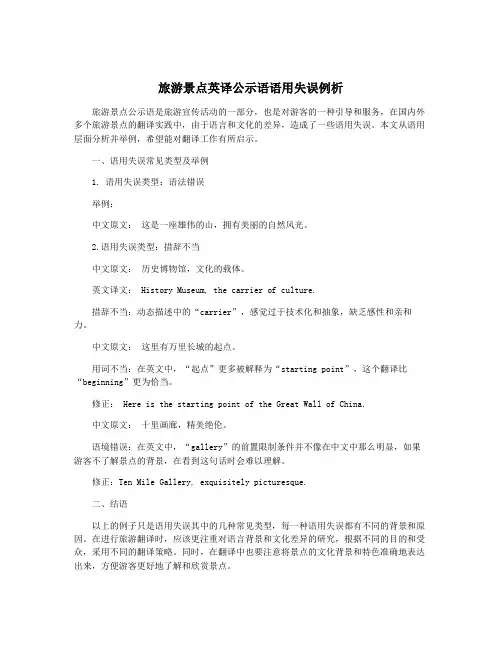
旅游景点英译公示语语用失误例析
旅游景点公示语是旅游宣传活动的一部分,也是对游客的一种引导和服务,在国内外多个旅游景点的翻译实践中,由于语言和文化的差异,造成了一些语用失误。
本文从语用层面分析并举例,希望能对翻译工作有所启示。
一、语用失误常见类型及举例
1. 语用失误类型:语法错误
举例:
中文原文:这是一座雄伟的山,拥有美丽的自然风光。
2.语用失误类型:措辞不当
中文原文:历史博物馆,文化的载体。
英文译文: History Museum, the carrier of culture.
措辞不当:动态描述中的“carrier”,感觉过于技术化和抽象,缺乏感性和亲和力。
中文原文:这里有万里长城的起点。
用词不当:在英文中,“起点”更多被解释为“starting point”,这个翻译比“beginning”更为恰当。
修正: Here is the starting point of the Great Wall of China.
中文原文:十里画廊,精美绝伦。
语境错误:在英文中,“gallery”的前置限制条件并不像在中文中那么明显,如果游客不了解景点的背景,在看到这句话时会难以理解。
修正:Ten Mile Gallery, exquisitely picturesque.
二、结语
以上的例子只是语用失误其中的几种常见类型,每一种语用失误都有不同的背景和原因。
在进行旅游翻译时,应该更注重对语言背景和文化差异的研究,根据不同的目的和受众,采用不同的翻译策略。
同时,在翻译中也要注意将景点的文化背景和特色准确地表达出来,方便游客更好地了解和欣赏景点。
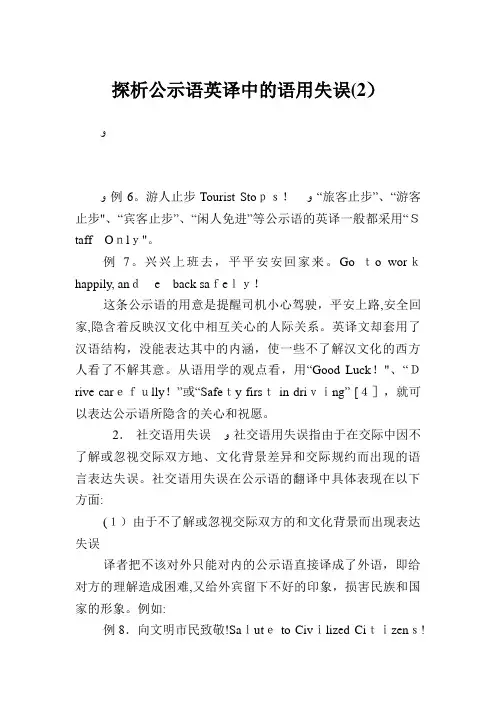
探析公示语英译中的语用失误(2)ﻭﻭ例6。
游人止步Tourist Stops!ﻭ“旅客止步”、“游客止步"、“宾客止步”、“闲人免进”等公示语的英译一般都采用“Staff Only"。
例7。
兴兴上班去,平平安安回家来。
Go to workhappily, ande back safely!这条公示语的用意是提醒司机小心驾驶,平安上路,安全回家,隐含着反映汉文化中相互关心的人际关系。
英译文却套用了汉语结构,没能表达其中的内涵,使一些不了解汉文化的西方人看了不解其意。
从语用学的观点看,用“Good Luck!"、“Drive carefully!”或“Safety first in driving” [4],就可以表达公示语所隐含的关心和祝愿。
2.社交语用失误ﻭ社交语用失误指由于在交际中因不了解或忽视交际双方地、文化背景差异和交际规约而出现的语言表达失误。
社交语用失误在公示语的翻译中具体表现在以下方面:(1)由于不了解或忽视交际双方的和文化背景而出现表达失误译者把不该对外只能对内的公示语直接译成了外语,即给对方的理解造成困难,又给外宾留下不好的印象,损害民族和国家的形象。
例如:例8.向文明市民致敬!Salute to Civilized Citizens!例9.争做文明游客,共建生态景区。
Be civilized visitors,set up the ecosystemscenery together!ﻭ这类用语是通过呼吁的方式诉诸市民的公德意识和道德觉悟,以规范本国市民的行为,所以实在是没有对外翻译的必要 [5]。
况且,读了这样的文字反而会产生不好印象,还以为该国市民和游客是uncivilized people(野蛮人)呢!另外,还有类似的“小心扒手”,“违者罚款”,“严禁”,“严禁随地吐痰、便溺”等明显具有本土意义的汉语公示语也没有必要译成外文. ﻭ(2)忽视文化和价值观念差异而导致的语用失误.许多公示语的英译错误不仅是用词不当或翻译不准确,其错误在于缺乏对中西方两种文化差异的了解.例10.(某市公共汽车告示)老年人优先候车Old People Waiting and Gettingon First在,我们常说“请为老、弱、病、残和孕妇让座"。
BI YE LUN WEN(20_ _届)英语公示语英译错误分析及翻译策略Mistranslation Analysis of Chinese Public Signs and English TranslationStrategies摘要公示语是一种给特定人群观看、有宣传性和服务性的广告文体。
随着中国国际化的脚步不断加快,大批外国人到中国旅游、投资、考察、求学等。
公示语英译也在其中起到了桥梁和纽带作用。
为了使国外友人准确地理解公示语表达的意思,减少存在于宾馆饭店、旅游景点等公共场所错误的、不规范的英文公示语,研究公示语具有很大的现实意义。
本文从跨文化意识的角度和语言层面探讨和分析了汉语公示语英译中存在的问题及其产生的原因,并提出了翻译原则和策略,旨在提高公示语汉英翻译质量。
关键词:公示语;错误分析;翻译策略AbstractPublic Signs, which are for a specific group of people, are propagandistic and service advertising style. With the development of Chinese economic,China’s position in the world is increasing gradually. As a large number of foreigners come to China for traveling, investing, investigating, studying, etc, English public signs play an more and more important role in communicatin. In order to make foreign friends understand more accurately what the public signs mean,decrease the wrong and non-standard English public signs in the public places of hotels, restaurants, tourist attractions, museums and so on, it is significant to make a research on public sign translation from English into Chinese. This paper focuses on the aspects of cross-cultural awareness and languages to analyse the existing problems and causes in Chinese-English translation of public signs. The paper also puts forward some translation principles and strategies to improve the quality of public sings translation. Key Words: public signs; mistranslation analysis; translation strategiesContentsAbstract (3)1. Introduction (1)1.1 Different Definitions (1)1.2 Practical Functions (1)1.3 Current Studies (2)2. Exist Problems in Translating Chinese Public Sings into English (2)2.1 Absence of Cultural Consciousness (3)2.1.1 Popular Chinglish (3)2.2.2 Unnecessary Translation (4)2.1.3 Ignorance of Cultural Differences (4)2.2 Language Mistakes (5)2.2.1 Inappropriate Expression (5)2.2.2 Wrong Grammar (6)2.2.3 Improper Spelling (6)3. Translation Principles (7)3.1 Focusing on Cross-Cultural Awareness (7)3.1.1 Focusing on Cultural Differences (7)3.1.2 Focusing on Reader's Thinking Model (8)3.2 Being Concise and Precise (8)3.2.1 Conciseness (8)3.2.2 Precision (9)4. Translation Approaches (9)4.1 Adapting (9)4.2 Borrowing (10)4.3 Creating (10)5. Conclusion (11)Bibliography (12)Acknowledgement (13)一、Introduction"Public sign" is the language of instruction in public places and widely used in all aspects of our lives. "With the promotion of China's international influence and economic strength, and the increase in technical writing, cultural exchange, the rise of sports activities, the phenomenon of bilingual public signs has become a beautiful language of style in China." (Yang Yongling, Liu Chunxia, 2008:47)From Beijing Olympic Games to the 2010 Shanghai World Expo and Guangzhou Asian Games held in 2010, more and more foreign tourists and investors come to China. Public signs are just like a country's business card and a city's face. But in the process of translation, more and more errors appear in public sign. The translation of public signs has great significance, which should be paid enough attention to. But English translation of public signs has many errors, it will not only directly affect the traveling and living of overseas friends, but in the long run, it will affect China's future political, economic, social and cultural development.1.1 Different DefinitionsIn Oxford English Dictionary, a sign refers to a characteristic device attached to or placed in the front of an inn or shop, as a means of distinguishing it from others or directing attention to it. According to the Webster's Third New International Dictionary, it is defined as a lettered board or other public display placed on or before a building, room, shop or office to advertise business there transacted or the name of person or firm conducting it. "Sign is a broad term, widely used in public facilities, ranging from travelling, catering, accommodation, recreation, shopping to medical service, educational institution and financial service. It includes words of caution, public notices, bills, posters, slogans, outdoor advertisements, traffic notices and so on." (Bei zhu, Ge Aiming2002, 26) Specifically speaking, it covers street signs, road signs, road markers, parking signs, school signs, construction signs, non-smoking signs, signs at scenic spots, slogans etc.1.2 Practical FunctionsPractical functions of the public signs include the following : indicating, promoting, restricting and compelling. Indicating, as its meaning suggests, is to indicate or guide readers. Signs as such are also calledinstructive/directive/guiding notices which give readers detailed information with no prohibition or restriction. Indicating is the most basic function performed of public sign. Indicating signs generally give readers relevant information about what it is and what services it provides. Prompting has no striking difference from indicating except that the former carries the tone of warning. It aims at reminding readers of paying considerable attention to signs. Restricting unlike the two functions mentioned above, signs that perform restricting function put restrictions and constraints to readers, who are expected to abide by certain rules in the interest of public. Restricting signs are to keep or confine within limits. Compelling , put it simple, compelling signs have great power and potency to induce action or brief. With its tough tone, negative words and comparatively uniform sentence structures, there is slight possibility of any alternatives.1.3 Current StudiesIn the West, the first study of public signs was beginning from Vinay & Darbelnet. They began to study public signs in 1959,form the book Comparative Stylistics of French and English. However, in China, although public signs have long been used for directing, warning, explaining in public places, the study of the Chinese-English translation started rather late, lacking systematization and standardization. Until the 1980s, some Chinese scholars began to study English translation of public signs; the" public signs" have been used in China. At the present century, translation of public signs gradually become the focus of attention of the translation area. With the 2002 Beijing International Studies University on the "English Translation of Public Signs" project received project funding and the establishment of publicity Translation Research Center, "public language" of the name was formally used. Strictly speaking, the attention we pay to the English translation of public signs is not enough, and research is not enough, which has resulted many problems in our country now. At present, there is little research on public signs. Therefore, to enhance the translation of public signs and take practical and effective measures to improve the quality of translation are very important and urgent.二、Exist Problems in Translating Chinese Public Sings into EnglishAlthough public signs have been used widely in our daily life, the nonstandard or inappropriate translation of public signs can be seen almost everywhere, in the street, in the hotel, in the restaurant or even in some museums.2.1 Absence of Cultural ConsciousnessNida once pointed that "To be bilingual, one has tube bicultural."(Nida,1969:52)There is a close relationship between cross-cultural awareness and the translation of public signs.If the translator lacks of adequate cross-cultural consciousness, the translation of public signs may not be recognized by the target audience. Over the year many distinguished scholars have observed this awareness and given some different definitions to cross-cultural awareness. Absence of cultural consciousness in translating Chinese public sings into English occurs more frequently. Next is to discuss it in detail.2.1.1 Popular ChinglishChinglish refers to a variety of spoken or written English that is influenced by Chinese . The term "Chinglish" is commonly applied to ungrammatical or nonsensical English in Chinese contexts, and may have pejorative or deprecating connotations. Li Wenzhong gives the definition of Chinglish. He pointed that , "Chinglish (literally 'Chinese-style English') refers to non-standard English, or malformed English which does not adhere to English cultural habits that appear in the course of English communication as a result of Chinese students/users of English suffering from the interference of their mother tongue, or arbitrary application of the rules and speaking habits of Mandarin."(Li Wenzhong, 1993, 32)The translation of public signs in China often has the same mistakes, which result in English readers suffering from the interference of their mother tongue, or arbitrary application of the rules and speaking habits of Mandarin. The examples of Chinglish are found on numerous translations of public signs.二、“关爱生命,请勿嬉水”is sign for tourists in Sichuan, has been translated into "Life is serious, do not fun."The true meaning of the sign is that it's dangerous to play water. However, the meaning of the translation is that life is serious, please do not joke. Therefore, it's complete departure from the original warning, and confuses foreign readers.2.2.2 Unnecessary TranslationInterlingua translation is possible because the similarities between languages are much more than the differences. The improper translation caused by cultural differences exists in many signs and the "unique" Chinese trademark. The reasons of mainly improper translation are not concerned about the target language culture in the extended sense, and regardless of different cultural backgrounds and feelings of foreign visitors. Some common public signs in the China can not find any trace in the English-speaking countries. Some public signs are completely against their local needs and behaviors. Translating between any two languages builds the theoretical basis of translation. This, however, does not mean that no differences exist between languages. Therefore, the translators should not firstly think about how to translate these signs exactly, but take"Is it necessary to translate them" into account.(2)“五讲四美二热爱”The sign has ever been translated into "Five Stresses, Four Beauties, Three Loves". This expression with a strong representation of Chinese culture, should be taken based on free translation; otherwise, it will not be accepted by the target culture, and will not achieve its purposes. Foreigners can barely accept this English translation. About such a situation, translators should know weather the translation is necessary or not.2.1.3 Ignorance of Cultural DifferencesLanguage is the integral part and the carrier of culture. Different languages have ethnic and cultural differences, which cause difficulties of translation. In order to achieve the best exchange effects, we should respect different cultural practices and cultural traditions. There are some differences between China and other countries in the use of public signs.Firstly, Chinese signs are more direct and straight forward;while,English signs often display the allowable aspect instead of aiming at the prohibited audience. Secondly, English signs generally use passive voice; Chinese signs, however, are more of active voice. Hence, translators should take into account the target reader’s acceptability and identification. If transistors ignorance of cultural differences will lead to many problems in translation.On the one hand, translation mistakes on the cultural level may make foreigners feel offended in terms of customs, beliefs, and faiths. On the other hand, there are lots of signs just belonging to Chinese culture but are translated word-for-word without taking account of the culturaldifferences which may cause misunderstanding. There are also public signs that exist in both cultures. However, the English versions are not so sound as well as Chinese ones which impress people firmly and vividly. They are not wrongly interpreted if they are translated in accordance with English customs or cultures. These translations can only express the superficial meaning without transmitting the spirit or the beauty of the sign to foreigners. Therefore, it is very important to understand the difference of the China culture and English-speaking countires culture. But there are a large number of modesl of this kind which can be found in our daily life.(3) “请给老幼妇残让座”has been translated into"Please give a seat to the old, weak, sick,disabled and pregnant women." In China, the sentence can be received; however, in English-speaking countries, old people are often reluctant to be called old, especially others use the "old" to describe them. They prefer to adapt a euphemistic way to express. It is better to be translated as "Please offer priority seats to those in need," which is more acceptable by foreigners.2.2 Language MistakesNow there are lots of public signs translation which is not correct or not accurate. These non-standard language translation errors can mainly be summarized in the following categories:2.2.1 Inappropriate ExpressionThe purpose of translation is to make readers get the correct information. Public translation largely needs concisenes to let the readers know the real meaning hidden in the text. Translators should transform language according to the characteristics of different languages rather than impose the structural features of a language on another. But there are lots of inappropriate expression in public sings translation. Rigid translation and hard translating are two common mistakes of public language translation.Both of them are direct translation according to the original words, contents, structures or sequences, which make others misunderstand the true meaning of public signs. The result may cause articles lose their original meaning, not only readers can not understand the message, but also cause readers’ misunderstanding of foreign culture. The reasons of rigid translation or hard translation aremost likely to ignore the true meanings of original signs, and lack of understanding in translation.(4) “小心碰头”has been translated as "Take care of your head". This is a typical mistake because of inappropriate expression. The true meaning of the sentence is hopes that readers be careful not to bump their head, but this translation is misunderstood by foreign friends. The best to translate it is "Watch Your Head" or "Mind Your Head".2.2.2 Wrong GrammarThere are very big difference between Chinese and English. But the translators often ignore the Sino-British differences between the syntactic; therefore they often make some basic mistakes when translating of public signs.(Wangying Lvhefa, 2007:14-15)This kind of translation shows the poor quality of C-E translation of public signs. Theoretically, wrong grammar can be avoided easily if the translator has the responsibility for his own interpretation. However, such mistakes can be seen everywhere. The wrong grammar signposts not only deface the city but also leave a poor impression to those foreigners about our Chinese culture.(5)“禁止攀爬”has been translated into " Please Do not Climbing". The use "Climbing" is not right here, it should be changed into" Plea se Don’t Climb" or "N o Climbing".2.2.3 Improper SpellingSpelling errors of translating public signs are the most common and most easily overlooked mistakes. But in fact, this kind of mistakes almost exists everywhere. About spelling errors, the following two types of errors should be paid more attention to: with distinction of the capital letters and wrong spellings. These errors reflect that translators are not careful in the process of translation, or lack of the basic capabilities to translate. Vocabulary or spelling mistakes are mostly because translators have not use a right attitude toward their work.(6)“宾馆预订服务”, which has been translated as "Hotel reservation servce" .The "servce” is significantly less letters "i".三、Translation PrinciplesAs public signs play a significant part in public and tourists, any ambiguity, misunderstanding, abuse of public signs will result in negative consequences. The public sign plays a very important role in the process of city internationalization. We should study the functional meaning and language style of public signs in English carefully."Therefore, to improve and enhance the quality of translation of public signs is imperative and important task." (Huang Youyi, Huang Changqi, 2005:8-9)Here are some translation skills.3.1 Focusing on Cross-Cultural AwarenessThe translation of public signs is to convert the source language into target language. In this process, it is necessary to remain the information in the source language, but also take cultural differences into account, so that the target readers can correctly understand the information.3.1.1 Focusing on Cultural DifferencesLanguage is the carrier of culture. Every nation has its profound cultural heritage. In different societies, the cultural background, national habits, thinking modes are different as well as the expression of their language. Different languages have ethnic and cultural differences, which cause difficulties in translation. In order to achieve the best exchange effects, translators should respect different cultural practices and cultural traditions. There are some differences between China and English-speaking countries in public signs, so we can’t use some words that can only be understood by ourselves.(7) “红旗手”once was translated into “a red flagger”. Our translation is to allow foreigners to read and understand our culture, ideology, but not a foreigner will know the real meaning of "a red flagger". In fact, it contains implied meaning "an advanced worker''. Thus we can just translate “红旗手”into "a model worker" or "an advanced worker". As for something that is uncertain even in the source text, translators can just leave it out.3.1.2 Focusing on Reader's Thinking ModelsThe translation of public signs is written for foreigners, so we should consider the target readers' thinking models and feeling. Public signs are a kind of application style with rich forms, which are being used in a wide range. But not all of the public signs can be translated into foreign language directly. Sometimes, in order to respect the feeling and expectations of readers, we may consider neglecting or replacing the impolite expression toward a reader.(8)“请勿践踏草坪”should not be rigidly translated into "do not tread on the meadow ", for the reason that target readers are more accustomed to expressions "please keep off the grass". These examples account for the necessity of considering the values and andthinking modes, which is not an isolated phenomenon but an integral part of culture. Hence, translators should adopt the “reader-centre” principle to enable the foreigners to fully understand the meaning of the signs.3.2 Being concise and precisePublic language translation should make foreign friends understand, and it should follow principles of conciseness and precision. Semantic translation and communicative translation can be realized in a precise and concise way. (Newmark, Peter, 1988:47).3.2.1 ConciseThe translator should know the language style of both Chinese and English pubic signs well. "There are five important features about English public signs: firstly, most of the public signs are written in capitals without full stop; secondly, the public signs are always short even with only one word; thirdly, the public signs are written in simple writing style, such as using lots of nouns, verbal nouns or phrases; fourthly, imperative sentences are used sometimes; fifthly, formal writing style is used sometimes". (Hu Wenzhong, 1987:78). As for Chinese public signs, the main feature is to use simple words to show simple meaning, that is to say, to be brief and concise. If a public sign is too long, it would be difficult for people to catch the main meaning of the contents.(9)“随地吐痰乞人恨罚款一千有可能传播肺病因此起卫生法例要遵行” .Obviously, this sign is written in a ragged verse in order to warn citizens not to spit everywhere. If it is translated into English word-for-word, the original meaning may have no effects on foreigners, who may take it as a joke. The proper translation can be "No spitting. Maximum penalty $1000".3.2.2 PreciseIt is very important to make readers understand the true meaning of the translation. Some experts considered the translation as a process of re-creation. If you don't make research deeply between the source language and target language, it is hard to master them. We establish precise as a basic principle for the public language. Chinese-English translation is based on the consideration of public language’s characteristic. If the translation is too obscure, it would not achieve the role of public signs that should be.(10)“注意安全,请勿攀爬单边墙”If we only translate it according to literal translation, foreigners may feel very odd, and difficult to understand. In fact, as long as we obey understandable principle and correspondingly translate as" Keep a safe ", it will let foreigners will feel intelligible and kind.四、Translation ApproachesThere are many ways to translate the English public signs. The translation approaches and translation strategies should be determined by the intended purpose or functions of a translation. According to the above principles, such translation approaches are to be discussed as adapting, borrowing and creating.4.1 AdaptingAdapting means a translator makes the slight change based on the similar expressions in English. It can guide the translator to make flexible target language choices when rendering culture-specific expression.The translator makes linguistic choices and employs translation strategies, especially when he is transplanting cultural images. In sign translation, someestablished signs in English can be adapted.(11)“桂林山水甲天下”is translated to “East or West, Guilin Landscape is best!”, which imitates the well-known English proverbs “East or west, home is best”. In this way, it arouses the amiableness on the part of readers, achieves the persuasiveness of the public sign and justifies the translator’s choice of a particular purpose in a given translational situation.4.2 BorrowingBorrowing is way which is highly practical and realistic in sign translation. Based on the approach, the conventional expressions of English signs could be borrowed so that they sound familiar and acceptable to the foreigners. Different individuals from different cultures would differ to a greater or lesser extent, but they would be culturally equivalent when they perform the same function in their respective specific setting culture. Just as Nida puts it, for truly successful translation, biculturalism is even more important than bilingualism, since words only have meanings in terms of the cultures in which they function.(12) “限时停车”has been translated into"Time Limit Parking". This translation is based on "parking".If we translate it without using borrowing approach,the translation may not be familiar by readers. Through using the approach, it can not only makes the task of translation simple, but also can make foreign friends feel comfortable.4.3 CreatingWhen performing the translation of signs with Chinese characteristics, we tend to adopt the method of creating. That is, translators should do the creative work when there are no conventional expressions to borrow or similar expressions to adapt from English signs. Therefore, the translator should have the abilities to create the translation not only understandable but also meet the expressing style of those English-speaking countries. It requires translators' linguistic choices and pragmatic translation strategies and translators must focus on conveying the author’s intentions and make readers get the true information. Otherwise, the appellative function of sign language will be absent.(13)“宁停三分,不抢一秒”can be translated as "It is far better to arrive late in this world than early in the next. " From this example, we can see that if it is difficult to translate public signs which have no conventional expressions to borrow or similar expressions to adapt, translators should do some creative work to translate it more consistent with English expressions.五、ConclusionNowadays, China is striving to improve the standard of opening to the outside world. Therefore, it is urgent to standardize various C-E translations of public signs. Since public signs have always been “the face of the city”, every citizen has the duty to point out the errors in signposts around us in our city.This paper discusses several aspects of the Chinese-English translation problems of public signs, especially the cultural phenomena in translations. According to the problems, the author offers some suggestions to establish standard translation of public signs. The author makes a conclusion that an accurate translation of public signs should always take account of the cultural factors in both languages. Let’s introduce our country to all over the world in the best way.Bibliography[1] Hatim, Basil. Communication across Cultures. Shanghai: Shanghai ForeignLanguage Education Press, 2001:89.[2] Nida, Eugene A. Language and Culture: Contexts in Translating [M]. Shanghai:Shanghai Foreign Language Education Press,2001:52.[3] Newmark, Peter.A textbook of translation[M].London:Prentice HallInternational(UK)Ltd,1988:47.[4] 北竹,革爱民. 谈英语公示用语的语言特点与汉英翻译[J]. 北京第二外国语学院学报, 2002,(5):26-29.[5] 胡文仲. 现代实用英语例解[M].上海:上海外语教育出版社, 1987:78.[6] 黄友义,黄长奇.翻译质量与翻译协会的责任[J]. 中国翻译, 2005,(5):8-9.[7] 罗选民, 黎土旺. 关于公示语翻译的几点思考[J]. 中国翻译,2006,(4):67.[8] 刘法公,徐蓓佳. 公示语汉英翻译原则探索[J]. 外语与外语教学,2008,(2):54.[9] 李文忠. 中国英语与中国式英语[J]. 外国教学与研究. 1993,(3):32.[10] 王颖,吕和发. 公示语汉英翻译[M]. 中国出版集团,中国对外翻译出版公司, 2007:14-15.[11] 杨永林,刘春霞. 双语公共标识的文本性研究[J]. 外语学刊, 1998,(2):47.AcknowledgementI would like to express my gratitude to all those who helped me during the writing of this thesis.My deepest gratitude goes first and foremost to Mr. Liu, my supervisor. From deciding the title to finishing this paper, I have gained lots of benefits from the enlightenment of Mr. Liu, whose inspiring insights, generous encouragements, and enthusiastic instructions have facilitated me much. He has walked me through all the stages of the writing of this thesis. Without his consistent and illuminating instruction, this thesis could not have reached its present form. Then I owe much to my friends and classmates for their valuable suggestions and critiques which are of help and importance in making the thesis a reality.开题报告英语公示语翻译中常见错误分析及策略选择六、论文选题的背景、意义(所选课题的历史背景、国内外研究现状和发展趋势)目的:随着我国经济的发展和对外开放步伐的加快,国际间的友好往来及经济合作日益增多,对外联系和国际交流日益频繁。
旅游景点英译公示语语用失误例析1. 引言1.1 介绍Traveling to different places is a wonderful way to explore the world and experience new cultures. One important aspect of traveling is understanding and communicating with the locals, which is why signage and public notices in tourist attractions play a vital role in providing information to visitors.1.2 研究意义研究旅游景点英译公示语语用失误的意义在于加深对语言传播和跨文化交流的认识,探索如何在传达信息的同时避免语言误导和理解差异。
英译公示语作为游客接触景点的第一印象,直接影响游客对景点的认知和体验。
深入研究旅游景点英译公示语的语用失误,有助于提高翻译质量,促进旅游文化交流,提升景点形象和吸引力。
通过分析语用失误的常见类型和影响,可以为相关从业者提供规范和改进方向,提高公示语的传播效果,营造更好的旅游环境。
对旅游景点英译公示语语用失误进行深入研究具有重要的理论和实践意义,有助于推动翻译传播领域的发展和提升。
2. 正文2.1 语用失误概述语用失误是指在语言交际过程中出现的、与语法、逻辑无关的语言错误。
在旅游景点英译公示语中,语用失误是比较常见的问题之一。
由于受到文化差异、语言表达习惯等因素的影响,翻译人员往往会犯下一些语用失误,导致翻译结果不达预期效果。
造成语用失误的原因可以是词汇选择不当、语言风格不恰当、表达方式不准确等。
有些翻译人员在翻译公示语时,会直译原文而不顾及目标语言的语言习惯,导致表达含义混淆或者丢失。
一些翻译人员也会出于节省时间或者粗心大意的原因,直接使用机器翻译,而不进行仔细核对,进一步加剧了语用失误的情况。
康定旅游饮食文化公示语藏汉英译文的误译
文化在旅游中起着非常重要的作用,除了景点和风景,饮食文化也是吸引游客的重要因素之一。
由于语言和文化差异,翻译中常常会出现误译的情况。
下面是一些常见的康定旅游饮食文化公示语的误译:
1. 正确译文:康定美食——酸辣土豆丝
误译:Kangding Cuisine - Sour and Spicy Potatoes Shreds
问题:将“土豆丝”直接翻译为“Potatoes Shreds”,缺少对中西饮食差异的理解。
可以将其翻译为“Spicy Shredded Potatoes”。
2. 正确译文:食在康定,快乐在心
误译:Eat in Kangding, Happiness in the Heart
问题:将“食在康定”翻译为“Eat in Kangding”,没有传达出“食在康定”的特殊含义。
可以将其翻译为“Eating in Kangding, Joy in the Heart”。
通过以上的例子,我们可以看出误译主要是由于对源语言和目标语言的文化差异和特色知识的不了解所导致的。
在进行翻译时,需要充分了解源语言和目标语言的文化背景,同时结合特定的语境和目标受众的需求,做到准确和恰当的翻译。
只有这样,才能更好地传递旅游饮食文化的魅力,吸引更多的游客。
镇江部分公园及饭店公示语汉译英翻译失误分析镇江市语委办公室随着改革开放的不断深入,我国加强了国际化都市和国际旅游景点的建设,许多城市的国际语言环境得到明显改善。
其主要标志是:双语公示语数量的明显增多。
但是,在公示语翻译中存在着大量的不规范、错译及误译的现象,已引起社会的普遍关注。
公示语翻译质量低下的现象在我国很普遍,影响着城市和国家的形象。
镇江是对外开放港口城市,公共场所用语不规范情况也比较突出。
2006年8月,据南师大外国语学院学生谢伟用两周时间在镇江市区发现的类似材料,证明镇江街头中英文对照的错误招牌(标志)竟达三成以上!发生在镇江街头的这些错误英文招牌,遍及闹市区中山路、解放路、长江路、梦溪路等路段的一些对外和涉外窗口,涉及金融、房产、装饰、餐饮、医疗等众多行业,其表现在中文对照不规范、词不达意,错误甚至歪曲原意等。
镇江市7座公园有4座公园使用双语甚至4语(日文、韩文)标志(如南山、焦山),宾馆中国际饭店、碧榆园、一泉宾馆、镇江宾馆使用多一些。
近期,根据省语委办公室的要求,市语委办公室派员走访了市区的公园和饭店、宾馆,抽查了一些示意性文字,发现了不少翻译的失误。
一、错译例1:停车场(国际饭店)原译:Park(Park 名词意思为:公园, 停车场, 炮场) 评论:park作名词时表示公园或别墅周围的园林,作动词时才表示停车。
此处表示“停车场”,应将动词名词化为“Parking”。
改译:Parking例2:待渡舫(焦山公园)原译:Waition Room评论:此处“waition”有误改译:Waiting Room例3:青螺居饭店(焦山公园)原译:Qingluoju Vegetarian Restaurant评论:改翻译意为“青螺居素食饭店”,但据考察,里面也卖荤食,故不准确。
改译:Qingluoju Restaurant例4:请勿随地吐痰(焦山公园的渡船舱内)原译:Qin Wu Sui Di Tu Tan评论:使用汉语拼音翻译,外国人看不懂。
公示语汉译英翻译常见错误[摘要]公示语英译文本在城市对外宣传自身形象的活动中起重要作用,并且,每个城市对于英译文本公示语的需求与日俱增。
对公示语汉英翻译中经常出现的错误进行分析,将汉语直接翻译成英语;英译文本语意交际效果欠佳;英文与汉语拼音混用等。
针对公示语翻译中出现的误译提出相应的,符合英美国家语言习惯的译文。
[关键词]公示语;汉英翻译近年来,随着中国与国际间交往的日益密切,在政治、经济、文化、旅游等方面加快与其他国家的融合与共同发展,中国在打开国门加快经济建设的同时,也注重文化的建设;现代化的生活节奏与国际化的文化环境,既满足了国际旅游者,外交人员,商务人员等在中国经历和体验不同“文化”的需要,又提升国家或城市的自身形象。
因此,对于到访的国际友人来说,要想让他们在中国有宾至如归的感觉,公共场所的英文公示语就显得非常重要,它明确地告诉信息接受者相关信息和友善提示。
所以,英文公示语对城市乃至国家的形象与对外宣传的影响显而易见。
毋庸置疑,在公共场所使用规范化的伴有英文的公示语对中国加快国际化进程将起到巨大的推动作用。
因此,正确的做好公示语英汉互译为外国友人提供便利的同时,展示良好的中国形象,已经成为伴随国际交流日益融洽过程中一件刻不容缓的事情。
如何使用恰当的词语及形式将公示语有关信息准确地传达给公众,是公示语汉英互译的关键所在。
公示语通常出现在醒目的位置,具有窗口的作用,其应用范围非常广泛, 几乎涉及到我们日常生活的各个方面, 如街头的路牌、廣告牌、路标、商店招牌、警示语、宣传语、旅游简介等等。
作为一种交际工具,它用图标或文字与图标相结合等方式把必要的、有用的信息传达给大众,是人们生活中不可或缺的帮手。
作为一种特定功能的文本形式,公示语应用历史久远,对其翻译研究意义深远。
在世界各民族的社会、文化、经济发展进程中,准确的公示语翻译对外籍人员来说,具有良好交际效果,可有效地对其规范社会行为,提高生产效率以及优化生存质量等方面。
由于公示语在传递信息中的语言特色和特殊功能,我们应该认清公示语翻译过程中可能出现的问题及背后的原因。
将极大地有助于翻译人员采取正确的翻译方法和翻译策略来解决问题。
要想解决以上问题,我们首先要了解公示语翻译研究趋势。
公示语的翻译研究在国外有比较长的发展历史,现在已经较为成熟和规范;而在中国,针对公示语方面的汉英翻译研究起步较晚,翻译界对此展开的研究还很不够, 缺乏体系性和规范性。
在国内学者中,吕和方指出了公示语的四种应用功能特征:指示性、提示性、限制性、强制性;分析了公示语的“动态”和“静态”信息,提倡在从事汉英公示语翻译时首先应考虑使用英语中规范和标准词汇进行一对一的汉英置换, 在无对应译法的情况下宜参照英语公示语的功能要求确定语言风格进行试译, 在确认不会产生任何误解的情况下才可实际应用。
公示语意在向公众传递信息,帮助公众了解周围环境或提醒公众注意其所在场合的特定特点。
公示语的使用对象明确,交际目的一致,应用范围清晰。
因此,情境相同,对象一致,目标清楚,转换对应,触景传情是公示语汉英翻译所应遵循的标准。
〔1〕然而,在对公示语英译的调查中发现,城市中公示语英译的现状令人堪忧,普遍存在着这样或那样的问题,影响城市形象并且阻碍城市外语语言环境的健康发展。
在日常生活中,错误的公示语翻译随处可见,其中最常见也最为明显的就是公示语的汉英翻译;这些常见错误为外国朋友在中国的生活带来诸多不便,也使中国的对外形象受到一定程度上损害。
〔2〕公示语翻译常见错误主要误译表现在以下几个方面:一、不考虑英美国家语言习惯,将汉语直译为英语汉英语言差异较大,英语重形,英语造句多用形合法;汉语重意,汉语造句多用意合法,不受形式约束,只要意义相关,就可以放置在一个不间断的语意流中,将分句统一在一个长句的形式之中。
英语公示语翻译侧重语意与信息的传递,公示语的译文应符合目的语读者的语言规范和使用习惯。
然而,日常生活中对照原文,生搬硬套地将汉语直接译成英语此类翻译错误也是随处可见。
例如:公园里设置这样的公示语“有您的参与,垃圾就不会无家可归”,其常见译文为“If you would like to join us, rubbish will never be homeless.” 我们都能理解此公示语的目的在于倡导,规范公众的文明行为。
然而,由于其译文过于忠实原文,将汉语逐词译出,略显生硬。
因为不准乱扔垃圾是我们必须遵守的道德行为,这是无可否认的,但译文中if和would like to的使用过于随意,并不能充分体现出不许乱扔垃圾的强制性。
由于此类公示语在国内外也是经常出现在公共场所,可直接引入其语用习惯做到洋为中用,建议将其译成No littering;Thank you for not littering 等。
再如,在某超市的散装食品区公示语写到“请让我们的员工为您服务,谢谢!”译文为“PLEASE LET OUR STAFF TO SERVICE YOU. THANK YOU! ”句中LET为使役动词,在英语语法结构中经常使用let sb. do sth.;并且service的词性为名词,句中误用为动词。
建议将此句译为PLEASE LET OUR STAFF SERVE YOU. THANK YOU! 或者PLEASE ASK OUR STAFF FORSERVICE. THANK YOU!二、公示语英译文本语意交际效果欠佳公示语着重强调读者的心理及行动反应。
公示语英译就是帮助和指导目的语读者对公示语的理解和反应,以便他们在异语言文化中能够更好地工作、学习、生活和出行。
因此,作为译者在对公示语这类文本翻译时应当以交际翻译的理论为指导,处处为译文读者着想,从译文读者的思维角度出发。
充分考虑到读者的生活环境、文化背景和语言习惯,让他们在异国他乡也能够清楚地理解公示语所包含的信息,并按照相关要求作出相应的预期行动,以免由于公示语翻译工作的不完善带给读者更多的麻烦,或产生不良的交际效果。
例如:我们通常将大型商场中的收银台译为Cashier,与前两处误用相比,译文没有语言表达的错误,表明了源语言的信息,实现了功能的对等。
然而,在英国的商场中收银台的英文标识通常为“please pay here”,这里面有一个“请”字,体现了“以人为本”服务宗旨的独到之处。
使公示语起到人性化信息传递功能和服务功能。
又如,游乐场售票窗口会有温馨提示“儿童一律购票”,其翻译为“All the children should buy the Ticket”,语气生硬,态度冷漠。
如果在ticket prices后面加括号注明for all ages 或是Adults and Children,即可达到说明任何年龄段的游客都应购票的目的,同时语气又十分亲和。
又如,“爱护绿化,严禁践踏”有的地方将本句译成Protect the environment and keep off the grass.翻译虽然忠实原文,却词不达意,虽然传递中文意思却语气生硬,所以,我们最好译成“Keep off the grass.” 使句子言简意赅。
三、英文与汉语拼音混用随着城市国际化步伐加快,公示语汉英翻译受到公众的足够重视。
尽管如此,还是出现了令公众困惑的公示语,即汉语拼音与英文混用。
城市的每条街、路都有具体的名称,如:和平街,我们总会看到在其附近的道路公示语标牌出现不同版本的译文,像HEPING STREET, HEPING A VENUE或HEPING JIE。
再如,中国的高铁火车票也同样出现了英文与汉语拼音的混用。
如:G13次列车从北京南开往南京南,车票英文译文为BeijingSouth→Nanjingnan。
South的汉语含义为南方、南部;而同样表达南京南时却用到了中国汉字“南”的汉语拼音。
此类问题一定会给外国友人带来困扰。
目前,类似的英文公示语错误现象普遍存在,急需国家出台相关的法律法规统一翻译标准,给从事公示语翻译工作者作出指导。
因此,更应该以严谨的态度来对待公示语的翻译与译文的统一,以免造成误解。
四、其他方面公示语英译中多数的错误还是英文单词的拼写错误,虽然多数误拼能得到公众理解,但也难免带来困惑。
译文中缺少字母比较常见,如:No moking (No Smoking) 和car parkng (Car Parking) 这样的公示语等。
其次,冠词的误用也较为常见,例如总服务台The general service counter的译文中多加了定冠词the;安全出口An emergency exit应去掉不定冠词an。
公示语是应用文体, 翻译须以读者为本, 符合英语表达习惯和思维方式, 真正达到对外交流和宣传的效果。
街头路牌、商店招牌、宣传语、警示语、旅游简介等, 因受时间和空间限制, 不便于详读,通常以简单明确为主。
此外, 公示语英译时,其作用是对外宣传翻译,不能简单地对号入座,而是要根据汉英两种语言之间的差异性, 对译文进行改写、重写、调整、梳理、深加工甚至再创作,才能使译文符合英语表达习惯,取得预期宣传效果。
公示语汉英翻译是目前国内翻译领域中正待开发并充分发展的又一公共研究性题目。
在对于各种语言的公示语翻译过程中有待更多的英语专业人士及相关工作人员在文化背景,句子结构,语言规范,质量标准等反面继续努力提高。
公示语翻译是一项庞大而琐碎的工程,需要翻译工作者乃至全社会的持续关注。
翻译过程中不仅涉及两种语言,而且还涉及两种社会文化。
语言是文化的载体,是具有不同语言文化背景的人互相交际、交流思想、达到相互了解的媒体。
〔3〕公示语汉英翻译时,译者应当在分析公示语汉语文本字面意义的同时认真、准确查找相对应的英语词汇,以及相关同义词在源语言文化使用中的具体语言环境,才能达到公示语翻译的实际功效。
尽量做到重视英汉两种语言文化的融合,使英语公示语与汉语公示语在同一场合下使用,达到相同的目的。
应该对公示语的翻译加以重视,使之规范化,为外国朋友营造一个舒适便利的服务环境,全面打造一个国际化的中国新形象。
〔參考文献〕〔1〕王颖,吕和发.公示语汉英翻译〔M〕.北京:中国对外翻译出版公司,2007.〔2〕王银泉.南京旅游景点公示语译文错误遍地开花〔J〕.广告大观:标识版,2007,(04).〔3〕王治奎.大学汉英翻译教程〔M〕.济南:山东大学出版社,2005.。